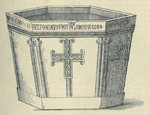
Catholic clergy involvement with the Ustaše covers the role of the Croatian Catholic Church in the Independent State of Croatia (NDH), a Nazi puppet state created on the territory of Axis-occupied Yugoslavia in 1941.

The ratlines were systems of escape routes for German Nazis and other fascists fleeing Europe from 1945 onwards in the aftermath of World War II. These escape routes mainly led toward havens in Latin America, particularly in Argentina, though also in Paraguay, Colombia, Brazil, Uruguay, Mexico, Chile, Peru, Guatemala, Ecuador, and Bolivia, as well as the United States, Canada, Australia, Spain, and Switzerland.
Francesco Maria Appendini was an Italian Latin and Italian scholar who studied Slavic languages in the Republic of Ragusa. The French invasion prevented him from returning to Italy, and he adopted Republic of Ragusa as his own country. He took it upon himself to investigate its history and antiquities.

Krunoslav Stjepan Draganović was a Bosnian Croat Catholic priest associated with the ratlines which aided the escape of Ustaše war criminals from Europe after World War II while he was living and working at the College of St. Jerome in Rome. He was an Ustaša and a functionary in the fascist puppet state called the Independent State of Croatia.

Bartol Kašić was a Croatian Jesuit clergyman and grammarian during the Counter-Reformation, who wrote the first Illyrian grammar and translated the Bible and the Roman Rite into Illyrian.

Johannes Lucius was a Dalmatian historian, whose greatest work is De regno Dalmatiae et Croatiae, which includes valuable historical sources, a bibliography and six historical maps. Due to his critical approach, he is often described as the "father of Croatian historiography".
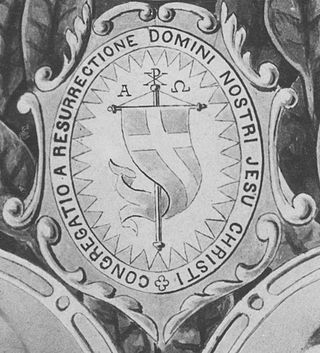
The Resurrectionists officially named the Congregation of the Resurrection of Our Lord Jesus Christ, abbreviated CR is a Catholic clerical religious congregation of Pontifical Right for men. It was founded in 1836 by three men, Bogdan Jański, Peter Semenenko and Hieronim Kajsiewicz on the heels of the Polish Great Emigration.
The Collegium Germanicum et Hungaricum, or simply Collegium Germanicum, is a German-speaking seminary for Catholic priests in Rome, founded in 1552. Since 1580 its full name has been Pontificium Collegium Germanicum et Hungaricum de Urbe. It is located on the Via di San Nicola da Tolentino.

Saint Jerome of the Croats is the national Catholic church of Croatia on Via Tomacelli in the Campus Martius of Rome. It is now a chapel of the Pontifical Croatian College of Saint Jerome in Rome and is only open to visitors by arrangement with the College.
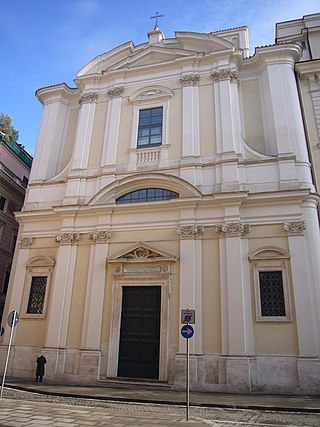
The Basilica di Sant'Apollinare alle Terme Neroniane-Alessandrine is a titular church in Rome, Italy, dedicated to St Apollinare, the first bishop of Ravenna.
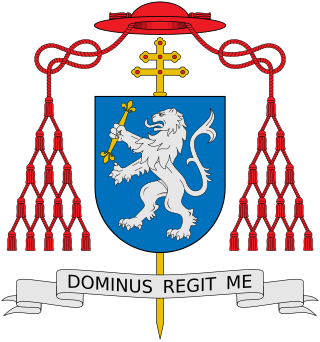
Pietro Ciriaci was an Italian Cardinal of the Catholic Church who served as prefect of the Sacred Congregation of the Council in the Roman Curia from 1954 until his death, and was elevated to the cardinalate in 1953 by Pope Pius XII.
Croatian art describes the visual arts in Croatia, and art by Croatian artists from prehistoric times to the present. In Early Middle Ages, Croatia was an important centre for art and architecture in south eastern Europe. There were many Croatian artists during the Medieval period, and the arts flourished during the Renaissance. Later styles in Croatia included Baroque and Rococo.
The Pontifical Commission of Sacred Archaeology is an official board of the Vatican founded in 1852 by Pope Pius IX for the purpose of promoting and directing excavations in the Catacombs of Rome and on other sites of Christian antiquarian interest, and of safeguarding the objects found during such excavations. In 1925, Pope Pius XI declared that the Commission was Pontifical and its competencies were defined in detail and reaffirmed recently in the conventions between the Holy See and the Italian State.
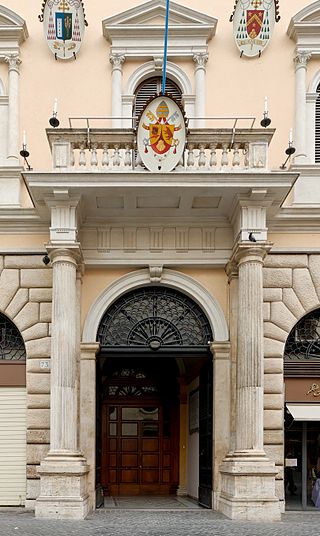
The Roman Colleges, also referred to as the Pontifical Colleges in Rome, are institutions established and maintained in Rome for the education of future ecclesiastics of the Catholic Church. Traditionally many were for students of a particular nationality. The colleges are halls of residence in which the students follow the usual seminary exercises of piety, study in private, and review the subjects treated in class. In some colleges there are special courses of instruction but the regular courses in philosophy and theology are given in a few large central institutions, such as Pontifical Urbaniana University, the Pontifical Gregorian University, the Pontifical Lateran University, and the Pontifical University of Saint Thomas Aquinas, Angelicum.

Pontifical Roman Athenaeum S. Apollinare is a former pontifical university in Rome, named after St. Apollinaris of Ravenna. Its facilities are now occupied by the Pontifical University of the Holy Cross.

The Pontifical Institute of Sacred Music is an institution of higher education of the Roman Catholic Church specifically dedicated to the study of church music. It is based in Rome, Italy, located in the former Pontifical Abbey of St Jerome-in-the-City.
Croats form a part of the permanent population of Italy. Traditionally, there is an autochthonous community in the Molise region known as the Molise Croats, but there are many other Croats living in or associated with Italy through other means, with the most numerous communities in Trieste, Rome, Padua and Milan. In 2010, persons with Croatian citizenship in Italy numbered 21,079.
Ignazio Jacometti was an Italian sculptor. He was a professor of sculpture at the Accademia di San Luca.
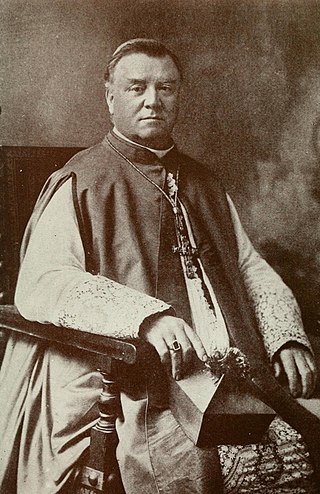
Thomas Francis Kennedy was a bishop of the Catholic Church in the United States. He served as the rector of the Pontifical North American College from 1901 to 1917.
Aleksandar Komulović was a Catholic priest and diplomat from Venetian Dalmatia. Part of the Counter-Reformation, and an early Pan-Slavist, he notably led a diplomatic mission aimed to forge an anti-Ottoman coalition in support of the West during the Long Turkish War, principally in the Balkans and among the Slavs. Although he failed his mission, he inspired the Serbs to revolt. The Papacy was aware that the Latin language of the liturgical books presented an obstacle for the conversion of the South Slavs from Islam and Orthodoxy to Catholicism. Komulović belonged to the first group of Jesuit missionaries and authors who attempted to spread Catholicism among the Slavs using liturgical books in Slavic. After his death, his propaganda activities were continued by Bartol Kašić.

